| Article ID | Journal | Published Year | Pages | File Type |
|---|---|---|---|---|
| 1371307 | Bioorganic & Medicinal Chemistry Letters | 2015 | 6 Pages |
Abstract
Computer-aided drug design scaffold hopping strategies were utilized to identify new classes of CB2 agonists when compounds of an established series with low nanomolar potency were challenging to optimize for good drug-like properties. Use of ligand-based design strategies through BI Builder (a tool for de novo design) and PharmShape (a virtual screening software package) approaches led to the discovery of new chemotypes. Specifically, compounds containing azetidine-, proline-, and piperidine-based cores were found to have low nanomolar and picomolar CB2 agonist activities with drug-like properties considered appropriate for early profiling.
Graphical abstractFigure optionsDownload full-size imageDownload as PowerPoint slide
Keywords
Related Topics
Physical Sciences and Engineering
Chemistry
Organic Chemistry
Authors
Eugene R. Hickey, Renee Zindell, Pier F. Cirillo, Lifen Wu, Monika Ermann, Angela K. Berry, David S. Thomson, Claudia Albrecht, Mark J. Gemkow, Doris Riether,
